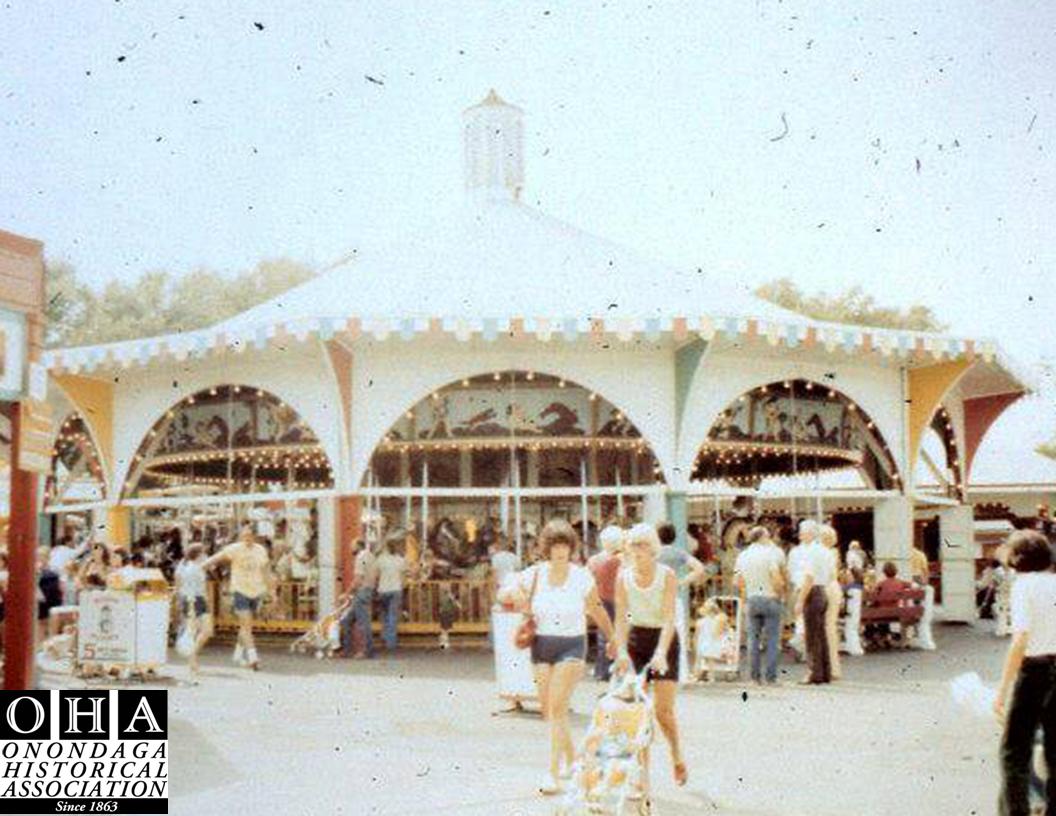
In October 2016, the iconic carousel at Destiny USA, formerly known as Carousel Center, will celebrate 26 years in that location. However, it led a somewhat circuitous route to its current home since the merry-go-round was first built in 1909. It was the eighteenth carousel made by the famous Philadelphia Toboggan Company (PTC), which explains its “official” industry designation as PTC #18. At the time the manufacturer was formed, in 1904, the term “toboggan” referred to a wooden roller coaster and, over the next hundred years, the company cranked out 147 roller coasters and 67 carousels, of which 33 still exist.
History
As many know, Destiny USA is the second local home of this much loved carousel. It delighted riders of all ages on the north shore of Onondaga Lake at Long Branch Amusement Park from 1926 until 1941, though the Park closed three years earlier in 1938. Prior to being at Long Branch, PTC #18 originally ran in Louisville Kentucky, then Worcester, Massachusetts, and then in Erie, Pennsylvania before it made its way to upstate New York. In 1941, the carousel was sold for $1500 to William Muar and George Long who over-saw a year-long refurbishment before placing it at Roseland Park, on the shores of Canandaigua Lake, in 1942 where it ran until Roseland finally closed on Labor Day, September 2, 1985.
PTC #18 has forty two “jumping” horses arranged in three rows. One horse was removed when the carousel was installed at Destiny USA to make the ride fully accessible to those with disabilities. That horse now stands alone on display not far from the merry-go-round. The intricately carved equines were all created especially for PTC #18 by the company’s master carver, Leo Zoller. Their long faces and close set eyes are hallmarks of Zoller’s design. The carousel also includes two beautiful chariots decorated with cherubs in high relief style, scenery paintings, and a Wurlitzer Artizan Band organ.
A Journey
After Roseland Park closed, the carousel was put up for auction by Norton Auctioneers in its September 16th, 1985 sale. Norton announced that the carousel would be sold piece by piece, then offered as a complete package at the individual bid total plus a twenty percent premium. Jim Tuozzolo, a partner at the Pyramid Companies of Syracuse, and his wife, Salli, fondly remembered bringing their young daughters to Roseland often to ride the carousel. Hearing about the auction, Salli mentioned that it might be a nice idea to buy one of the horses as a memento of those wonderful family outings. Jim happened to mention his intentions to Bob Congel, the principle partner at Pyramid. Congel, a veteran shopping mall developer, had been thinking of building a mall along Onondaga Lake in his home town of Syracuse and imagined the carousel would make an ideal focal point for such a facility. At that moment, he decided to buy the entire carousel and return it to the shores of the lake as the centerpiece and the namesake for his new mall.
The Carousel Comes Home
Tuozzolo represented the Pyramid Companies at the auction and, after the horses, which went for high bids ranging from $3,000 to $20,000 each, the accompanying Wurlitzer band organ, and its twenty seven rolls, were bid at $15,000. With the rest of the carousel (apart from the horses and the organ) bid at $13,000, the grand total of individual high bids for the entire unit came to $331,250. The twenty percent premium added another $66,250 for a total package price of $397,500. As tensions mounted in the packed auction crowd, Tuozzolo waited patiently. When the auctioneer finally asked if anyone in the hushed assemblage wanted to make the bid necessary for the carousel to be sold complete, Tuozzolo slowly raised his hand and bought the entire package at the new world record price for a carousel sold at auction. The room erupted into cheers and extended applause as the exceptional carousel was saved intact.
The new record price would soon soar to over $400,000 as the Pyramid Companies also paid for the rights to one horse, which was mysteriously missing from the auctioned carousel.
Sometime between the 9th and the 11th of September, 1985, about one week before the auction, one of the horses was stolen from the carousel. It is believed that the perpetrator(s) entered the locked carousel building through the ticket booth, stole the horse, and escaped by boat over Canandaigua Lake. After purchasing PTC #18, Pyramid Companies hired a private investigator to track down the missing horse. Salli Tuozzolo, who was put in charge of managing the restoration of the carousel, made it a personal mission to find the stolen property and remarked, “I felt like a member of my family was missing.” The publicity about the theft was extensive, making it practically impossible for the horse to be sold without notice.
Finally, in May of 1988, a Rochester lawyer contacted Pyramid and, eventually, provided them with the complicated directions that led them to a remote dirt road in Manchester, Ontario County, where the missing horse was located, wrapped in plastic, and buried in a farmer’s field.
Restoration
PTC #18 underwent a million dollar restoration that took over two years. The entire carousel was repaired and painted in the original 1909 colors by Bill Finkenstein of R & F Designs from Bristol, Connecticut. It made its stunning debut in the Carousel Center in October of 1990, almost fifty years after its last bow on the shores of Onondaga Lake. The ride, and the organ, are regularly maintained and annually inspected under the supervision of Destiny USA General Manager Rob Schoeneck. Paint touch-up is periodically done by artist Susan Germain who says, “I wish all owners of operating carousels had this level of dedication to the health and longevity of their antique machine.”

